At last Thursday's Board of Visitors meeting former rector Gordon F. Rainey jokingly suggested that the Board send its architectural plans to the New York Times, a reference to Adam Goodheart's New York Times article published in late May which criticized the University's architecture and the structural plans for the South Lawn project. For some, however, the situation has not been a laughing matter.
Plans for the South Lawn project have been heavily debated at the University. For years, former architect James Polshek worked on designs for the project, but none of them were ever sent to the Board for approval, according to University architect David Neuman.
Last spring, Polshek resigned his duties as the architect for the South Lawn Project, and the job was given to John Ruble, a University alumnus who had spent many months studying the plans.
In April, with a unanimous vote, the Board of Visitors approved Ruble's design, the first to go to the Board for approval, Neuman said.
The reason Goodheart was attracted to the University's architecture and the controversy surrounding the South Lawn project was because of his interest in "stories about how the influences of the past are still felt in the present."
Goodheart said he felt that the Board's decision to approve Ruble's design was a bit hasty, but perhaps a sense of fatigue had set in among the board members, prompting them to accept the newest design.
"I think everybody realized that there needs to be some amount of compromise," Neuman said. "[The BOV] saw something that was almost more than the sum of the individual parts."
In his article, Goodheart compared the architecture of the University's Lawn to that of Harvard's Yard. When a new building was erected among the others in the Yard over the years, architects used more modern techniques when designing the buildings. He referred to this as a "continuing intellectual project."
The newer architecture of the Lawn, on the other hand, such as Old and New Cabell, attempt to replicate a Jeffersonian neo-Classical design, he said.
Goodheart favors the architecture of the Yard because it shows the longevity and vitality of the school, whereas the white-columns and redbrick details of the new design for the South Lawn look like "a Marriott hotel version of neo-Classical architecture," he said.
Goodheart said that there is a way to combine tradition and maintain a continuing intellectual project, but Ruble's design does not achieve this.
"I feel like he stayed in the shallow end of the pool...and didn't take as many risks," he said.
Neuman disagreed with the statement, saying that the new design is a more modern interpretation of Jefferson's design of the Lawn.
"There are so many things that are essential to the design...and so far [it] has been very well received," he said.
Colette Sheehy, vice president of management and budget, said that Ruble's design was what the board and the dean were all looking for.
"This is a project that is definitely of a character that is going to advance people's thinking of architecture and landscaping here at the University," Neuman said.






